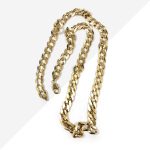
Rolled gold, also known as gold-filled, is a material made by bonding a layer of gold alloy to a base metal, usually brass. This process involves mechanically bonding a thin sheet of gold to the surface of the base metal through a combination of heat and pressure.
This isn’t to be confused with gold-plated jewelry. For rolled gold products, the gold layer is thicker than gold plating, making it more durable, longer-lasting, and of course more valuable. Gold-plated jewelry is essentially worthless because it contains almost no gold at all, but rolled gold can hold some value depending on how it’s produced.
Put simply, the thicker the rolled layer of gold, the more valuable your pieces will be worth.
The term “rolled gold” comes from the manufacturing process, where the gold layer is rolled onto the base metal. The proportion of gold in rolled gold items is specified by the karat value. For example, a piece of jewelry marked as “1/20 12K rolled gold” means that 1/20th of the total weight is 12 karat gold. For a small piece, this won’t amount to very much value at all, but for larger collections or bigger pieces, the value can add up.
It can be tough to distinguish the difference between gold-plated, rolled gold, and pure gold to the untrained eye. Rolled gold jewelry is usually marked as noted above, or more simply with “RG” or “RGP” (rolled gold plate). In cases where it’s marked with just the initials, you’ll need a fancy metal analyzer to determine the composition of the piece – which of course we have at Cash for Gold Mailer. This allows us to determine the exact amount of gold in the piece quickly and quote you an accurate price.
Rolled gold jewelry can provide the appearance of solid gold at a more affordable price. It is a popular choice for quality jewelry items that offer a balance between durability and cost. Keep in mind that the thickness of the gold layer can vary, and it’s important to check the markings on the jewelry to understand the gold content.
Jewelry marked “1/20 12k rolled gold” is only worth half as much as one marked “1/10 12k rolled gold”. So the difference is very important.
The value of rolled gold jewelry depends on various factors, including the thickness of the gold layer, the karat value of the gold, and the overall condition of the item. Basically, what you need to do is calculate the actual amount of gold present if it were to be boiled down just to pure gold.
Here are some key considerations to help do that math:
Let’s take a look at a couple examples:

Rolled Gold Necklace #1
Weight: 16g (0.5144119 troy ounces)
Marking: “1/20 12k rolled gold” (5% of the weight is 12 karat gold)
Amount of gold (in ounces): 0.01286
Approximate intrinsic value: $27.97

Rolled Gold Necklace #2
Weight: 18g (0.5787134 troy ounces)
Marking: “1/10 14k rolled gold” (10% of the weight is 14 karat gold)
Amount of gold (in ounces): 0.03376
Approximate intrinsic value: $73.43
At first glance, the two necklaces above look very similar, but due to slightly different compositions of rolled gold and different purities, one necklace is worth nearly three times what the other is worth. That’s why the thickness and purity of the rolled gold is very important in determining the value.
The value of rolled gold jewelry adds up much slower than regular gold jewelry. There’s no denying it. That said, if you have several pieces like Necklace #2 that value can become substantial, netting you hundreds of dollars or more for your unwanted jewelry.
If the above necklaces had been composed of 12k and 14k gold instead of just rolled, Necklace #1 would have been worth about $560, while Necklace #2 would fetch more than $730. So if you have “real” gold to sell in addition to rolled gold, your payout will skyrocket.
It’s important to note that the intrinsic values above are not what you’d be offered at a jeweler or cash for gold service. Depending on the quantity that you have to sell, you’ll likely be offered 50-80% of the intrinsic value of the gold. These pieces are considered “scrap gold” and would need to be melted down and recast to be of a higher quality grade. For more information on cash for gold pricing, check out what we pay for your gold now!
To determine the specific value of a rolled gold item, it’s recommended to consult with a professional appraiser or a jeweler who can assess its characteristics and provide an accurate valuation based on current market conditions. Because only a portion of the weight of the piece is made of gold, a metal analysis is the best way to determine the value of your piece. That equipment is typically only owned by professional gold buying companies.
Ready to get started? Request a free cash for gold mailer from us today and get a free, no-obligation appraisal and offer for your unwanted gold.
POSTED IN: Gold Necklaces, Gold Purities, Gold Value Calculator, Gold-Filled, Metal Analyzer, Post Slider, Rolled Gold, Value of Gold, Vintage Gold
By submitting your information you agree to our
Privacy
Policy and Terms and Conditions.


